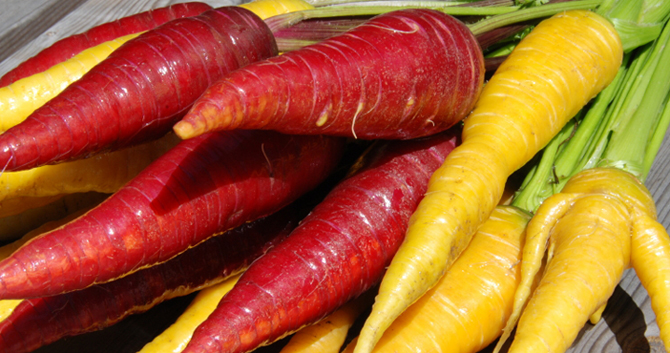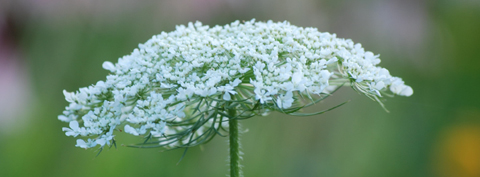 Wild carrots are closely related to Queen Anne's Lace.
Wild carrots are closely related to Queen Anne's Lace.
Carrots are the second most popular vegetable in the world after potatoes. And it’s no wonder—this incredible root vegetable offers a wide range of health benefits, long shelf-life, and versatile cooking options. They’re the perfect addition to any meal, a great crunchy snack, and easy to grow in the home garden.
History:
Wild carrots originated in Afghanistan from a close relative of the wildflower we know today as Queen Anne’s Lace. Unlike the long, sweet orange carrots we’re accustomed to, these early carrots were small, tough, bitter roots originally deep purple or yellow in color.
Initially embraced for their aromatic leaves and seeds, wild carrots were carried by trade caravans to Asia, Africa, and Europe. With centuries of cultivation, new varieties became larger, sweeter, and more colorful. Eventually the Dutch crossbred red and yellow varieties to create the carrot’s iconic orange color.
Types:
 Carrots come in a surprising array of colors, sizes, and shapes.
Carrots come in a surprising array of colors, sizes, and shapes.
Growing carrots is a great way to sample unique varieties in a surprising assortment of colors, shapes, and sizes. Ranging from purple, dark red or bright orange to light yellow and even white, they can be long, thin and tapered; short and stout; and even compact and round.
Although there are hundreds of carrot varieties, the four main types are grouped by the type of soil they require. As a rule of thumb, the longer and more tender the carrot, the looser and sandier the soil it needs. These types, listed in order of tolerance of heavy soils, are as follows:
- Imperators are the classic long, thin, tapered roots you’ll recognize from the grocery store. They typically grow from 8 to 11 inches long and are very tender and flavorful. These are a great all-purpose carrot for cooking, salads, and snacking. They need a deep sandy soil for best results and store well after harvesting.
- Nantes are an heirloom variety from Brittany with a sweeter, more subtle flavor than other carrots. Their crisp, tender, red-orange roots aren’t tapered like other carrots, instead growing into a cylindrical shape about 7 inches long. Nantes carrots are tender and mild when harvested early as a baby carrot, growing sweeter as they mature. High in sugar, they’re excellent for juicing and snacking. They grow easily in a range of climates preferring fertile, sandy loam. Once harvested, they’re more perishable than other varieties, but fortunately they freeze well for later use.
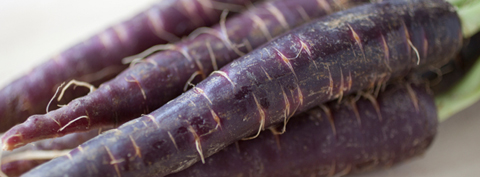 Look for heirloom varieties to add color and interest to salads and main dishes.
Look for heirloom varieties to add color and interest to salads and main dishes.
There are many other novel varieties for the home gardener, like mini and radish style carrots with short round roots, maroon carrots with a sweet apple flavor, deep purple outer color and inner orange core, or crisp, sweet planet carrots for early spring planting. Ask your local garden center for suggestions on what varieties do well in your area.
Getting started:
Carrots are hardy and easy to grow. Like most root crops, they prefer cooler growing conditions, performing best in spring and fall. When selecting the site, choose a spot that gets at least 6 hours of sun per day. Carrots need regular watering, so be sure the garden hose or sprinkler easily reaches the garden plot.
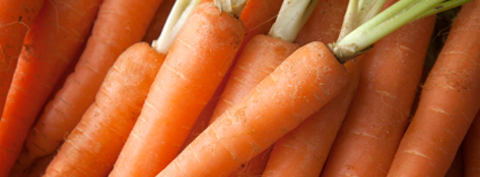 Carrots need deep, loose soil to grow long and straight.
Carrots need deep, loose soil to grow long and straight.
Site preparation is especially important for carrots since all the action is underground. They need a deep loose soil for best results - any obstacles like rocks or compacted soil can cause carrots to fork around the impediment. Start by loosening the soil and breaking up any clumps. Add compost to create a garden bed deep enough for the varieties you plan to grow.
For container plantings, use shorter varieties like Danvers, and Chantenay. Raised beds are best for longer varieties like Imperators and Nantes.
Care Tips:
Carrots grow best when planted early (but after danger of frost), giving them time to establish before the summer heat. They can also be planted in late summer for a fall harvest.
Planting: Plant carrots in rows twelve inches wide and leave 3 inches between plants to avoid overcrowding. Rows should be spaced at least 2 feet apart to leave room to walk between rows for weeding and harvesting.
Watering: Carrots do best with consistent soil moisture. Water weekly during dry spells, taking care to water deeply so moisture penetrates the full root zone, not just the first few inches.
Mulching: Cover the soil around plants with a thick layer of mulch to keep carrots cool and moist. As frost approaches at season’s end, you may extend the harvest season by insulating the rows with straw to prevent the ground from freezing.
Fertilizing: Carrots do not require fertilizer. In fact, excessive nitrogen can cause thick skin and promote too much top growth.
Harvesting:
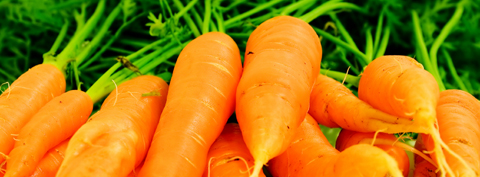 Carrots get their bright orange color from Beta-Carotene.
Carrots get their bright orange color from Beta-Carotene.
Depending on the variety, carrots mature in 60 to 80 days, but can be harvested earlier if desired. You can begin to enjoy smaller varieties when they are about ½ inch in diameter, and larger varieties at about 1 inch in diameter. Although the root is underground, the top of the carrot will show at the soil line to help gage the size.
In warm winter areas where the ground doesn’t freeze solid, late-planted carrots can be left in the ground and harvested as needed. In cold winter climates, wait as late as possible to dig remaining carrots for storage; the cold weather will make the carrots sweeter.
Companion Plants:
Take advantage of plants that grow well with carrots, deterring pests, improving taste, and beautifying the garden. The following plants are good companions when planted along with carrots:
- Onions, shallots, leeks, and chives help protect against pests and improve growth and flavor.
- Beans encourage growth.
- Peas and radishes help improve flavor.
- Aromatic herbs like rosemary, parsley and sage help deter insects.
Conversely, there are a number of plants that don’t make good neighbors for carrots, competing for nutrients or attracting unwanted pests. Steer clear of planting any of the following too close to carrots:
- Dill and anise compete with carrots and can inhibit their growth
- Parsnips may attract pests that will also bother carrots
- Tomatoes may inhibit carrot’s growth — though tomatoes benefit from having carrots nearby
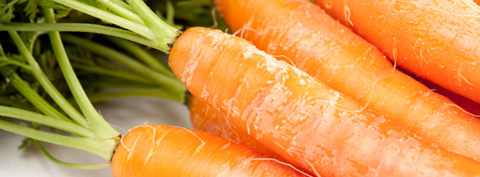 Eating two carrots a day has been shown to lower cholesterol 10-20%.
Eating two carrots a day has been shown to lower cholesterol 10-20%.
Several edibles share space well with carrots, using the garden plot to full advantage. Use the space between carrot plants to tuck in the following:
- Lettuce and onions have shapes that allow close planting with carrots. Carrots use the deeper soil, and provide shade for the lettuce.
- Radishes develop their roots quickly compared to carrots and will be harvested before the carrots are ready to use the space.
Troubleshooting:
Carrots are generally low maintenance plants with few problems. The most common harvest surprise is carrots which fall short of supermarket perfection.
Oddly shaped or forked carrots result from rocky or heavy soils that distort growth. Fortunately they’re still edible even though they’re not pretty and are more difficult to clean.
Spindly or stubby carrots are likely caused by soil temperatures that are too hot or too cold for optimal growth. Be sure to plant early but after danger of frost has passed and mulch well to keep soil uniformly cool through the hot summer months.
Long cracks or splits down the length of the carrot roots are a sign of inconsistent soil moisture. Mulching and regular watering will prevent this problem.









